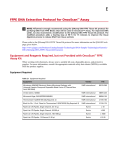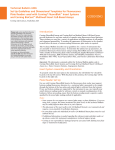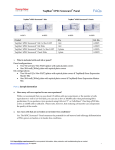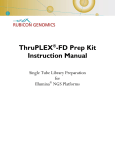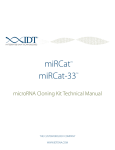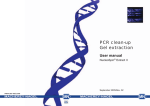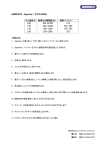Download Complete Genomics Sample Quality Control Protocol
Transcript
Sample Quality Control Protocol Updated August 2012 DNA Quantitation ...................................................................................................................................................... 2 Materials Required .................................................................................................................................................................. 2 Preparing a PicoGreen Working Solution ...................................................................................................................... 2 Preparing the DNA Samples................................................................................................................................................. 3 Preparing DNA Standards ..................................................................................................................................................... 4 Determining DNA Quantitation .......................................................................................................................................... 4 Expected DNA Quantitation Reproducibility ............................................................................................................... 5 Gel Electrophoresis ................................................................................................................................................... 6 Materials Required .................................................................................................................................................................. 6 Preparing the Agarose Gel .................................................................................................................................................... 6 Loading and Performing Electrophoresis of the DNA Samples ........................................................................... 7 Inspecting Gel Images ............................................................................................................................................................. 8 These instructions describe the procedures used by Complete Genomics to quantitate and verify the integrity of DNA samples submitted for complete genome sequencing. Sample acceptance is based on results of this QC process. DNA is quantitated using the Quant-iTTM PicoGreen® dsDNA kit from Invitrogen and integrity is verified using agarose gel electrophoresis. Complete Genomics uses liquid handling robotic systems for all liquid transfer steps in this process, but the same procedure can be applied using manual pipettes. Complete Genomics data is for Research Use Only and not for use in the treatment or diagnosis of any human subject. Information, descriptions and specifications in this publication are subject to change without notice. Copyright © 2011 Complete Genomics Incorporated. All rights reserved . UG_QC-02 Complete Genomics Sample Quality Control Protocol DNA Quantitation DNA Quantitation Note: The quantitation instructions include modifications to those provided by Invitrogen in the Quant-iT™ PicoGreen® dsDNA kit user manual: probes.invitrogen.com/media/pis/mp07581.pdf The process of quantitating samples to prepare for submission to Complete Genomics includes the following steps: Preparing a PicoGreen Working Solution Preparing the DNA Samples Preparing DNA Standards Determining DNA Quantitation The document also includes a description of the variation in DNA quantitation over time to help you assess the success of your process: “Expected DNA Quantitation Reproducibility”. Materials Required Quant-iTTM PicoGreen® dsDNA kit (Invitrogen, Cat # P7589) http://products.invitrogen.com/ivgn/product/P7589 Control DNA of known concentration (75 to 150 ng/µL) Tecan SpectraFluor fluorescent plate reader, or equivalent 96-well full-skirted PCR plate ( VWR, Cat # 10011-228), or equivalent UV-star 96-well micro-plate (VWR, Cat # 82050-788), or equivalent 1X TE, pH 8.0 Plate vortexer Plate centrifuge Adhesive plate seals or plate heat sealer Aluminum foil Preparing a PicoGreen Working Solution The PicoGreen reagent is diluted in preparation for DNA quantitation. Note: The PicoGreen working solution must be made fresh on the day of use. For best results, the solution should be used within a few hours of its preparation. Further, the PicoGreen solution should be protected from light, by covering it with foil or placing it in the dark, as the reagent is susceptible to photo degradation. Prepare a 1:200 dilution of the PicoGreen reagent in a 15 mL conical tube according to Table 1. Mix well by vortexing. Table 1: Preparation of diluted PicoGreen Reagent Number of Samples 1X TE, pH 8.0 Volume (mL) PicoGreen Reagent Volume (µL) 1-24 25-48 48-72 73-96 4 7 9 11 20 35 45 55 © Complete Genomics, Inc. 2 Complete Genomics Sample Quality Control Protocol DNA Quantitation Preparing the DNA Samples The following steps describe diluting DNA samples by a factor of 1:1,200 in a three-step serial dilution and placing the samples into the quantitation plate. Samples can be quantitated only in columns 1 to 11 of the 96-well quantitation plate (maximum of 88 samples); column 12 is reserved for the Lambda DNA standards. Note: For accurate concentration, DNA should be in the approximate concentration range of 30 to 300 ng/µL. 1. If frozen, thaw DNA samples completely. 2. Mix DNA samples thoroughly by vortexing for 20 seconds on a plate mixer at setting 8. Centrifuge briefly to collect contents at the bottom of the plate wells. 3. Prepare Dilution Plate 1: Label a PCR plate as “Dilution Plate 1”. Add 15 µL 1X TE pH 8.0 to each well positions for which a sample will be quantitated. Add 15 µL 1X TE pH 8.0 to one additional well for a control DNA sample. 4. Add 5 µL of a control DNA sample at a concentration of 100 ng/µL to the control well. Seal the plate and mix by vortexing for 20 seconds at setting 8. Centrifuge briefly to collect contents at the bottom of the plate wells. Prepare Dilution Plate 2: Label a PCR plate as “Dilution Plate 2”. Add 42 µL 1X TE pH, 8.0 to all well positions for which a sample will be quantitated. 5. Transfer 5 µL from each DNA sample to the corresponding well on Dilution Plate 1 (1:4 dilution). Transfer 3 µL from each well in Dilution Plate 1 to the corresponding well on Dilution Plate 2 (1:15 dilution). Seal the plate and mix by vortexing for 20 seconds at setting 8. Centrifuge briefly to collect contents at the bottom of the plate wells. Prepare Quantitation Plate: Label a UV-star 96-well micro-plate as “Quantitation Plate” Add 95 µL 1X TE pH 8.0 to well positions for which a sample will be quantitated. Transfer 5 µL from each well in Dilution Plate 2 to the corresponding well on the Quantitation Plate (1:20 dilution). Seal the plate and mix by vortexing for 20 seconds at setting 8. Centrifuge briefly to collect contents at the bottom of the plate wells. © Complete Genomics, Inc. 3 Complete Genomics Sample Quality Control Protocol DNA Quantitation Preparing DNA Standards The following steps describe preparing a Lambda DNA working solution and serially diluting it in column 12 of the Quantitation Plate to create a standard curve. 1. Remove the 100 µg/mL Lambda DNA standard stock tube from the PicoGreen kit and mix well by vortexing. Spin briefly to collect contents to the bottom of the tube. 2. Prepare a Lambda DNA working solution at a concentration of 500 ng/mL by adding 5 µL Lambda stock DNA to 995 µL 1X TE, pH 8.0 (1:200 dilution). Mix well by pulse vortexing for 10 to 20 seconds. Spin briefly to collect contents to the bottom of the tube. 3. Prepare a serial dilution of the Lambda DNA working solution in 100 µL volumes as follows: 4. Add 100 µL 1X TE pH, 8.0 to wells B12-H12 of the Quantitation Plate. Add 100 µL of the Lambda DNA working solution (500 ng/mL) to wells A12 and B12 of the Quantitation Plate. Mix the contents of well B12 by pipetting up and down 10 times to result in a DNA concentration of 250 ng/mL. Transfer 100 μL from well B12 to well C12 and mix by pipetting up and down 10 times to result in a DNA concentration of 125 ng/mL. Continue in this manner to prepare dilutions at 62.5 ng/mL (well D12), 31.2 ng/mL (well E12), 15.6 ng/mL (well F12) and 7.8 ng/mL (well G12) as indicated in Table 2. Table 2: Lambda DNA Serial Dilution 5. Well Final Lambda DNA Concentration (ng/mL) A12 B12 C12 D12 E12 F12 G12 H12 500 250 125 62.5 31.2 15.6 7.8 0 Discard 100 μL of the 7.8 ng/mL dilution from well G12. Do NOT add it to well H12. Well H12 will contain 100 μL 1X TE pH 8.0 representing 0 ng/mL of the Lambda DNA standard. Determining DNA Quantitation The following steps describe adding PicoGreen reagent to all samples, incubating the Quantitation Plate, and determining sample concentrations from standard curve after measuring fluorescence in a plate reader. 1. Add the reagent to the samples as follows: Add 100 µL of the PicoGreen working solution to each well of the Quantitation plate that contains a sample (control or standard DNA). Seal the plate and mix by pulse vortexing for 30-45 seconds at setting 8. Centrifuge briefly to collect contents at the bottom of the plate wells. Cover the plate with aluminum foil and incubate at room temperature for 10 minutes. © Complete Genomics, Inc. 4 Complete Genomics Sample Quality Control Protocol DNA Quantitation 2. Wipe the bottom of the Quantitation Plate with a KimWipe cleaning tissue. 3. Carefully remove the seal and place the plate in the microplate reader following the manufacturer’s instructions. An excitation wavelength of 480 nm and an emission wavelength of 520 nm should be used. 4. Generate a standard curve by plotting the fluorescence values determined for the Lambda DNA standards against the corresponding DNA concentrations. The slope of a line fitted to this curve should be between 21 and 27. If the slope is outside this range, you need to discard this Quantitation Plate and generate a new Quantitation Plate and repeat the quantitation. 5. Calculate the concentrations for each sample DNA and the control DNA from the standard curve using a dilution factor of 1,200. Verify that the concentration determined for the control DNA is in the expected range. Expected DNA Quantitation Reproducibility As an estimate of expected day-to-day reproducibility, we have included a run chart of the slopes of standard curves during a six-month period (Figure 1). Within our hands, we expect a +/- 15% range in slope (21 to 27) over time. Worst case, this should translate to +/- 15% variation in our quantitative measurements and those of our customers who follow this procedure. Data are provided below. Figure 1: Consistency in Standard Curve Slopes Over the Course of Six Months DNA Quantitation Standard Curve Slopes © Complete Genomics, Inc. 5 Complete Genomics Sample Quality Control Protocol Gel Electrophoresis Gel Electrophoresis The process of verifying the integrity of your samples using agarose gel electrophoresis includes the following steps: Preparing the Agarose Gel © Complete Genomics, Inc. 6 Complete Genomics Sample Quality Control Protocol Loading and Performing Electrophoresis of the DNA Samples Inspecting Gel Images Gel Electrophoresis Materials Required Agarose (IBI Scientific, Cat # IB70042), or equivalent 1X TBE buffer 96-well full-skirted PCR plate ( VWR, Cat # 10011-228), or equivalent GeneRuler™ 1 kb Plus DNA Ladder(Fermentas, Cat # SM1333), or equivalent 5X gel loading dye (Amresco, Cat # E274), or equivalent Lonza GelStar nucleic acid gel stain (Fisher Scientific, Cat # BMA 50535), or equivalent Gel documentation system (AlphaImager from Protein Simple), or equivalent Gel electrophoresis system (Thermo Scientific D2 wide gel system, Cat # D2), or equivalent Power source Preparing the Agarose Gel The following steps describe preparing a 0.8% agarose gel in a gel mold. 1. Mix 0.48 g of agarose with 60 mL of 1X TBE buffer in a conical flask. 2. Heat the mixture in a microwave until the agarose is completely dissolved (approximately one minute). 3. Mix well by swirling and allow to cool to 50 – 55oC. 4. Prepare gel casting tray by sealing the ends of the gel chamber with tape or appropriate casting system. Place an appropriate number of combs in a gel tray. 5. Add 1 µL of GelStar staining reagent to the cooled gel, mix well by swirling, and pour into the gel tray. 6. Allow gel to set for 15 to 30 minutes at room temperature. 7. Remove comb(s), place the gel in electrophoresis chamber and cover with 1X TBE buffer. © Complete Genomics, Inc. 7 Complete Genomics Sample Quality Control Protocol Gel Electrophoresis Loading and Performing Electrophoresis of the DNA Samples The following steps describe preparing dye for the electrophoresis, putting samples and dye in the agarose gel, including a DNA ladder, and performing the electrophoresis. 1. Prepare a 1.67X gel loading dye by mixing 50 µL of 5X gel loading dye with 100 µL TE. 2. Prepare the gel plate: Label a PCR plate as “Gel Plate”. Transfer 4 µL from each well of Dilution Plate 2 to the corresponding well of the Gel Plate. Include the control DNA sample. Add 6 µL of 1.67X gel loading dye to each sample in the Gel Plate. Seal the plate and mix by vortexing for 20 seconds at setting 8. Centrifuge briefly to collect contents at the bottom of the plate wells. 3. Prepare the GeneRuler™ 1 kb Plus DNA Ladder by mixing 1 µL of ladder with 36 µL of the 1.67X gel loading dye prepared in step 1. 4. Load 2 µL of the diluted ladder into the first well of the gel. 5. Unseal the Gel Plate and load 4 µL of material per sample to a well of the gel, starting with the well adjacent to the one containing the ladder. 6. Load 2 µL of the diluted ladder into the well adjacent to the last sample. 7. Place the lid on the gel apparatus, connect to the power source, and electrophorese for one hour at 80 volts. 8. Image the gel using a gel documentation system following the manufacturer’s instructions. © Complete Genomics, Inc. 8 Complete Genomics Sample Quality Control Protocol Gel Electrophoresis Inspecting Gel Images Use the gel images to verify that the DNA for each sample is of high molecular weight and is double stranded. Examine the gel profile for each sample to verify the presence of a single band above the location of the 20 KB band of the GeneRuler™ 1 KB Plus DNA Ladder (see Figure 2A). The control DNA should also have a single band of high molecular weight DNA. Samples for which a high molecular weight band is not present and a significant amount of the DNA is smeared below the 5 KB band of the ladder are deemed to be degraded (see Error! Reference source not found.). These samples will fail the Complete Genomics QC process. Samples in which the DNA is partially denatured will have a second high molecular weight band that represents single-stranded DNA. This single-stranded DNA band will run above the double-stranded DNA band (see Error! Reference source not found.). The presence of single-stranded DNA may negatively impact the quality of the resultant sequence data. Figure 2: (A) Gel Image Illustrating High Quality DNA Samples with Single High Molecular Weight Bands (B) Gel Image Illustrating Degraded Samples (Indicated by Arrows) (C) Gel Image Illustrating Samples Containing Single-Stranded DNA (Indicated by Arrows) © Complete Genomics, Inc. 9










